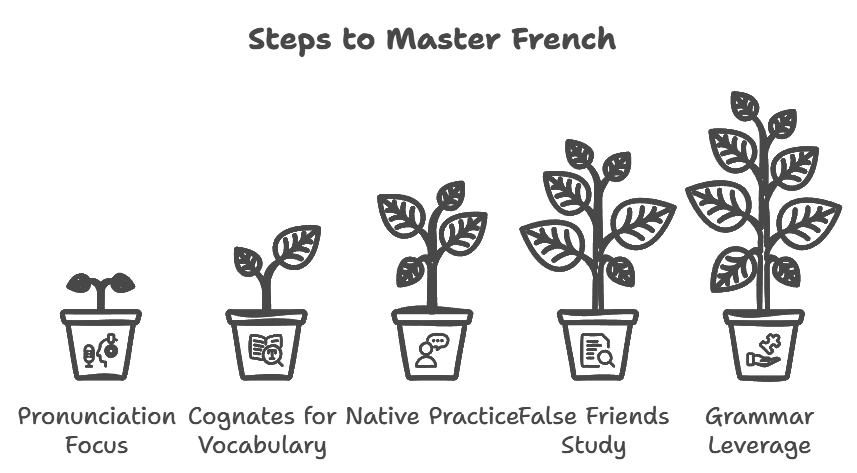Learning French as a Spanish speaker is notably easier compared to learning it from scratch with English or other non-Romance languages. Thanks to shared Latin roots and similar grammatical structures, Spanish speakers typically require 30-40% less time to achieve proficiency in French.
Key Takeaways
- Spanish speakers can reach French B1 level in approximately 300 hours, compared to 400 hours for English speakers
- Both languages share about 75% of their vocabulary through Latin roots
- Grammar structures are similar, though French pronunciation presents unique challenges
- Regular practice with native speakers significantly accelerates learning
- False friends between Spanish and French require special attention
Linguistic Foundations
French and Spanish share deep linguistic connections as Romance languages. This relationship creates significant advantages for Spanish speakers learning French, particularly in vocabulary and grammar structure.
Vocabulary Similarities The shared Latin heritage means many words are similar or identical. Here’s a comparison of common word patterns:
| Spanish | French | English |
|---|---|---|
| Universidad | Université | University |
| Información | Information | Information |
| Familia | Famille | Family |
| Hospital | Hôpital | Hospital |
Learning Timeline
For Spanish speakers, the journey to French fluency is typically faster than for speakers of non-Romance languages. Here’s what you can expect:
- A1 (Beginner): 75-80 hours
- A2 (Elementary): 150-180 hours
- B1 (Intermediate): 300-350 hours
- B2 (Upper Intermediate): 500-550 hours
Common Challenges
While Spanish speakers have advantages, certain aspects of French require special attention:
Pronunciation Differences French features 11 vowel sounds compared to Spanish’s 5, making pronunciation a significant challenge. The French ‘u’ sound and nasal vowels are particularly tricky for Spanish speakers.
False Friends Some words look similar but have different meanings:
- “Actuel” (current) ≠ “actual” (real)
- “Déception” (disappointment) ≠ “decepción” (deception)
- “Entendre” (to hear) ≠ “entender” (to understand)
Effective Learning Strategies
To maximize the advantages of being a Spanish speaker:
- Focus on pronunciation from day one
- Use cognates to rapidly build vocabulary
- Practice with native speakers regularly
- Study false friends systematically
- Leverage similar grammar structures

Technology and Resources
Modern technology offers specialized tools for Spanish speakers learning French:
Recommended Resources
- Language exchange platforms for Spanish-French practice
- AI-powered pronunciation tools
- Comparative grammar apps
- French media with Spanish subtitles
Career Opportunities
Being bilingual in Spanish and French opens numerous professional doors, particularly in:
- International organizations
- Diplomatic services
- Multinational corporations
- Tourism and hospitality
- Translation and interpretation
Cultural Integration
Understanding French culture is crucial for language mastery. Spanish speakers often find cultural similarities that aid in language acquisition, particularly in:
- Social customs
- Family values
- Dining etiquette
- Business protocols
Professional Development
For career advancement, consider these certifications:
- DELF (Diplôme d’études en langue française)
- DALF (Diplôme approfondi de langue française)
- TCF (Test de connaissance du français)
These credentials are particularly valuable for Spanish speakers seeking to validate their French proficiency in professional contexts.
Remember, while Spanish knowledge provides a significant advantage in learning French, consistent practice and immersion remain key to achieving fluency. The journey might be shorter for Spanish speakers, but it still requires dedication and systematic study.
